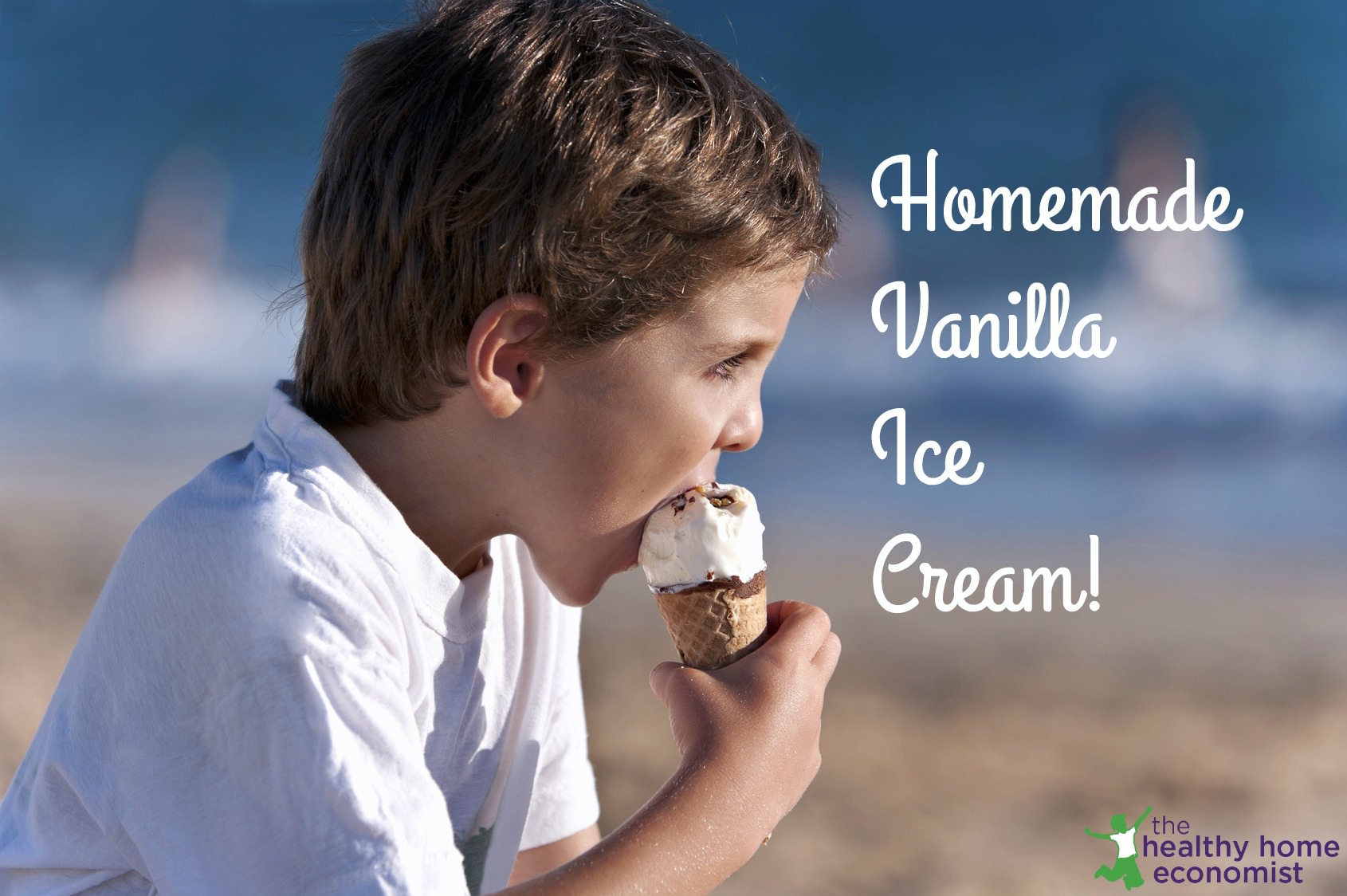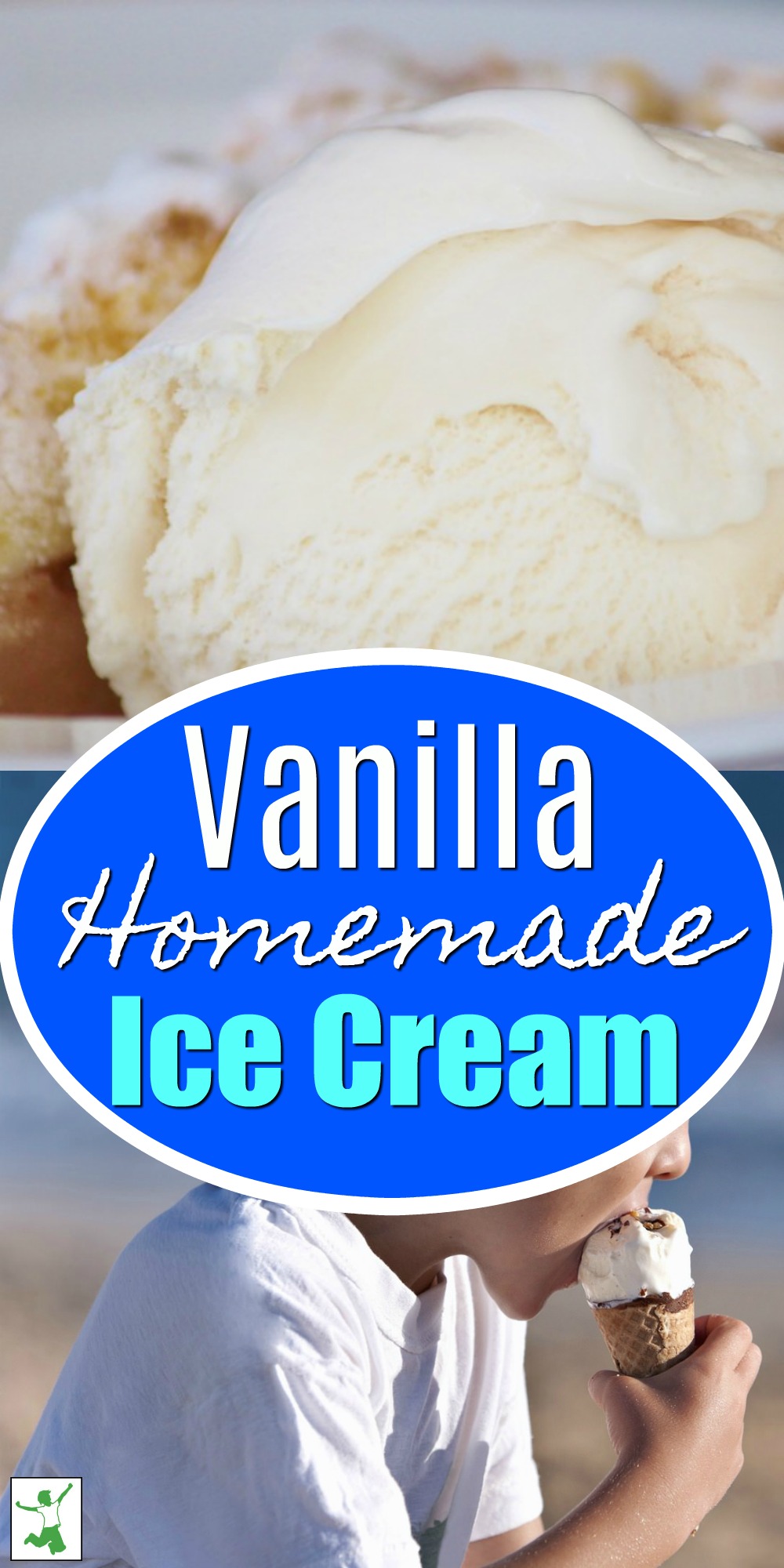
As a follow-up to a blog from earlier this week regarding toxic chemicals like propylene glycol, aka antifreeze in commercial ice cream, this recipe plus video shows you how to make homemade vanilla ice cream with wholesome, nutrient-dense ingredients.
There is simply no substitute for making ice cream yourself. I’ve often advised people over the years that the best use of your time in the kitchen is making things you can’t easily buy. Wholesome, healthy ice cream is one of these “things”. Bone broth is another important one, by the way, on the savory side of the spectrum!
Even organic ice cream is loaded with refined “organic” sugar. The homemade version contains Grade B maple syrup, a much healthier and more mineral-rich choice.
Not only is the sugar non-refined in homemade ice cream if you use Grade B maple syrup, but much less sweetener is used as well. For example, in the recipe below, 1/2 cup of homemade vanilla ice cream contains approximately 12g of sugar (in the form of maple syrup). The same amount of Julie’s Organic Ice cream (vanilla) contains 18g of sugar and Haagen Daaz plain vanilla contains 21g of sugar!
That is a lot less sugar in the homemade vanilla ice cream!
Of course, the cream you would source for homemade ice cream is higher quality too. Low temp pasteurized or (preferably) fresh cream from a grass-based dairy farm would contain far more nutrition than the cream from even organic cows, which are frequently still confined eating highly unnatural “organic” feed.
You will immediately notice that when you make your own ice cream, it is much more satisfying and you won’t eat nearly as much as supermarket ice cream. The lower butterfat content in supermarket and even organic ice cream results in eating more – much, much more. Believe me, ice cream manufacturers know this fact very well!
You eat more, they SELL more! Cha-ching!
Julie’s Organic Ice Cream, for example, contains cream and the second ingredient is skim milk. Remember – pig farmers feed their pigs skim milk to make them very, very fat). A lower butterfat content in your ice cream will cause you to eat more, a LOT more, which is why homemade ice cream with high butterfat will satisfy you quicker and you will eat far less.
If vanilla ice cream is not your thing, check out this recipe for dairy-free peanut butter ice cream.
How to Make Vanilla Ice Cream (+ Video Tutorial)
The video in the recipe below shows you how easy it is to make vanilla ice cream yourself.
Try drizzling this no-cook homemade chocolate syrup on top for a healthy treat with no compromises!
What a huge difference from commercial brands Twistee Treat or Jack Nicklaus Ice Cream, which is artificial almost everything! Even organic brands contain nearly double the sugar and are low butterfat to encourage overeating and check the politically correct nutrition box.


Homemade Vanilla Ice Cream Recipe
How to make homemade vanilla ice cream using only wholesome ingredients that contains about half the sugar of even organic or premium brands at the store.
Ingredients
- 3 egg yolks preferably pastured
- 3 cups heavy cream preferably raw and grassfed
- 1/2 cup maple syrup dark
- 1 Tbl vanilla extract
- 1 Tbl arrowroot powder
- 2 Tbl vodka optional (to soften and improve scoopability)
Instructions
-
Beat egg yolks briefly in a large, glass bowl. Do not use regular store eggs. Preferably use local, free range or pastured eggs washed in warm, soapy water before cracking. Organic store eggs are ok in a pinch.
-
Beat in remaining ingredients and pour into your ice cream maker. Follow your ice cream machine directions for how long the ice cream is churned.
-
When the ice cream is frozen and ready (about 15-20 minutes for my machine), pour into a shallow, glass baking dish. Cover with a lid and keep in the freezer.
Recipe Video
Recipe Notes
Do not use ultrapasteurized cream as it is highly allergenic and basically undigestible.








Last year I read about making ice cream using sweetened condensed milk. I buy the organic kind, which I know has refined sugar in it, but a small amount per serving. I started by making Meyer lemon ice cream—juice from enough lemons to get a good flavor balance when the juice is mixed into the condensed milk, chill mixture, then beat three cups of heavy cream to stiff peaks, beat in the condensed milk mixture, pour into a loaf pan, and freeze. I was amazed by the purity of the flavor, and a small amount is very satisfying. I get at least 20 servings out of it (probably more because, unless I’m serving guests, the servings are so small), so less than 10g of sugar per serving. I’ve also made pumpkin and chocolate, and each one is incredibly delicious. Beating the air into the cream is so much easier than churning. It turns out hard as a rock, just like you said, but after slight softening, the texture is beautiful. This year I might try condensing raw milk myself and sweetening it with completely unrefined sugar.
Should everything be refrigerated before we start making the ice cream.
Yes of course. Cream should always be refrigerated and kept cold.
hi Sarah. I’m trying to make your icecream in a thermomix. mostly thermomix recipes say to heat at 80 degrees Celsius for 5 minutes. will this destroy my raw cream goodness? also is there any way I can make it with a thermomix? do you know? thanks so much!
I don’t have experience making ice cream with a thermomix, but heating to 80 Celsius is equivalent to 176 F which is higher than pasteurization temperature! Yes, it would destroy all the goodness of the raw cream 🙁
Is there a way to make this without an ice cream maker?
Not easily that I know of.
Not that I know of without a lot of manual effort.
what about during pregnancy? No raw eggs. 🙂
If the eggs are high quality (NOT supermarket eggs) and washed in warm, soapy water before cracking, they are safe to eat raw … I ate homemade ice cream made with raw eggs for all three of my pregnancies! I drank raw milk too (high quality and grassfed of course).
I would like to achieve the “soften and improve scoopability” result without using vodka (or any other ethanol beverage, regardless of the amount). Are there any non-alcoholic alternatives to PPG available?
I did not notice anyone asking, so can you tell me how long would it last if it remains cold or in freezing temperatures.
—The maple syrup, though good, is still too many carbs – for me. Was wondering whether I could substitute stevia, & still have a decent consistency.
—Was also wondering whether there was a way to do this, without an ice cream maker.
Hi Sarah,
I just received an ice cream maker that has been used and I noticed there are some slight scratches in the bowl. Is this going to mean that aluminum would get in the ice cream? I don’t know if I should use it. Thanks in advance
Another commenter asked this and there was no reply. Can the cream be replaced with either almond or coconut milk? Thank you in advance.
No, this recipe won’t work with these substitutions.
We too love ice cream. We usually buy the “best” we can afford but we realize it is not that great.
I would love to get all the great ingredients mentioned here, to make the healthiest ice cream possible but I simply do not have access to them. The biggest obstacle is of course not finding the cream– I only can find uUHT cream. Most is imported from Denmark, France or some other European country.Even the stuff from local dairies is UHT.
Anyway, I have considered using creme fraiche to make ice cream.(I can find organic pasteurized creame fraiche, from Wales.)Is that possible?
As far as other ingredients, I can actually find organic Grade B Maple syrup but only organic free range supermarket eggs.
What would you consider the best option?